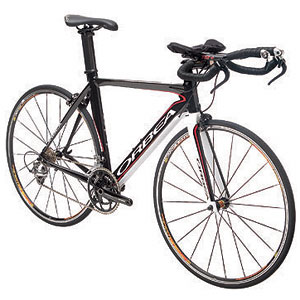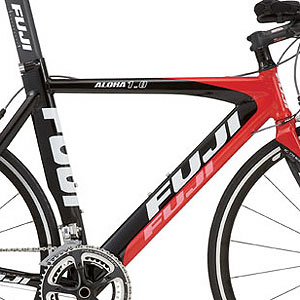2nd step from Felt, Orbea

Felt
At the 2006 edition of Interbike, the cycling world's important North American trade show, Felt unveiled a line of bicycles that remains the biggest step forward, one year to the next, that any brand has made in triathlon at least since the turn of the decade. Felt went from a disastrous-fitting bike line to a spectacular fitting bike line, such frames also exhibiting the sex appeal and functionality to work well both for triathletes and for the riders on what is now the Garmin-Chipotle team.
What shoe makers call a "last" and what car makers call a "chassis" is in Felt's case a "frame" that forms the basis for almost its entire tri bike line. Save for the S32, all the other tri bikes Felt makes—seven in all—pop out of this one size run of molds. Felt places a different modulus carbon, or affixes its Bayonet fork and, presto, another bike model. This has become a common theme (consider QR's Seduza, Caliente and Lucero) and no company does it more artfully than Felt.
B16
If you want to hop aboard a frame popping out of this Felt mold, but you're on a restricted budget, the B16 is your recession buster. The nice thing about a mold that's been around for a couple of seasons, if there were any problems with shifting, clearances, straightness, they'll probably have been sorted by now. So what you have is this very nice handling, extremely-well fitting frame, with a "lesser" fork to suit the price point, and you're off and running.
The price Felt hits with the B16 is $2300, and few all-carbon bikes come in underneath that price. Felt outfits the B16 with a Shimano 105 front and rear derailleur, and a "Shimano" chain and cassette which can mean something so low on the Shimano totem pole these iterations don't even bear model names. But that's okay, because nothing Shimano makes is that cheesy and, besides, these are "consumables," like tires and handlebar tape. Just know that you'll "consume" this chain and cassette a bit more quickly, so be prepared to replace each in a year or so.
The cranks are FSA Gossamer TT Mega EXO, an acceptable but not spectacular spec choice. Gossamer and Omega cranksets, the lower-end aluminum cranks from FSA, are typically what'll come on these low-$2000 all-carbon framed tri bikes.
An awful lot of the B16 is spec'd with Felt's proprietary parts. Rims, hubs, saddle, aerobars, stem, pursuit bar, are all Felt-branded, and the brake calipers exhibit no brand. See my exhortation to bike companies on their house brands. I'm not against house brands, I'm in favor of them, because a complete bike seller should enjoy the freedom to design the parts he feels he needs to make his bike work as he think it ought. Nevertheless, there is always the temptation to use low-cost items churned out by no-name factories, and retailers and end-users must always hold brands accountable for parts that bear the house brand logo. Are aerobars, saddles, forks, stems, handlebars, wheels and wheel parts, as commodotized and ubiquitious as nuts and bolts? No, they're not.
The line of Felt aerobars on its tri bikes is new. The retailers to whom I've spoken are striking a wait-and-see posture, but they're cautiously optimistic. The extensions are either S-bend or of a traditional J-shape, depending on where you cut the extensions. There seems to be good adjustability and modularity but, frankly, I haven't spent any time with these bars and the information on Felt's website about them is scant to nonexistent, depending on the model of aerobar we're talking about (nonexistent in the case of the bar on the B16).
Felt does one thing no other major tri brand does: it makes its smallest two sizes with 650c wheels. If you're shorter than 5'7", go on our Slowtwitch reader forum and ask folks of a similar height whether they'd be willing to give up their 650c bikes. Four times out of five, you'll find you couldn't blast them off those wheels with a stick of dynamite. Felt caters to these shorter riders with well-conceived bikes that make the 48cm and 50cm sizes among the very best in the size run.
You've got to spend $800 more to climb aboard the Felt tri bike next up in the pecking order. You don't get that much more bike for the extra money—Ultegra derailleurs and crank/bb on the B12 in place of the 105/FSA on the B16, slight upgrades in wheel parts, saddle. A slightly different aerobar assembly. Discernable variants in ride and mechanical quality, as you first hop aboard a B16 versus a B12, will be few to nil. The B16's drivetrain parts will wear out slightly quicker than the B12's parts.
As a consumer, I'm always drawn to that place in a company's lineup where they're really straining to make a margin—where the company's bean counters wince as they look at how much money they're not making on an item, and just shrug their shoulders and say, "We'll make back our margin on the other models." That's the soft spot where, as a consumer, I figure I'll get my best value. If I was to guess, I'd say the B16 is that soft spot. This might be the most Felt for the least dollars.

Orbea
If it's strictly a case of sex appeal, Aletta is outside Orbea's sweet spot. The hottest Orbea SKUs are the Ordus, all-carbon frames with stealth fighter lines, and especially in certain sizes—51cm and 54cm in particular—these Ordus match the way the typical North American (and Northern European) triathlete rides his bike more closely than the geometries of the Aletta.
Aletta
The Aletta is an aluminum bike, and must compete with all-carbon bikes such as the Kuota K Factor, Felt B16, and Quintana Roo's Seduza, as well as the carbon/aluminum matrix that Giant calls its Trinity Alliance. All these bikes sell between $2000 and $2350 so the Aletta, at $2150, is right in between bikes that carbon lovers will think out-horsepower this metal Orbea.
The Aletta is built in five sizes, all of which are built in the sorts of geometries that were more characteristic of tri bikes built five or ten years ago. The seat angles are shallow at 76°, and the head tubes trend large, relative to the "reach" of each size. The top tubes are on the short side, meaning you don't have too much room to steepen this bike by moving the saddle forward of the nominal seat angle, because the bike will then become too short for all but the long-leg, short-torso sort. But the Aletta does have a dual position post, for those who do want to ride it on the steeper side.
The aerobars are Profile Design's T2+, which is okay, except the extensions are less ergonomic than Profile's Cobras. The spec is about what you'd expect from a bike of this price point, with Ultegra derailleurs and FSA's Gossamer crank.
There is an Aletta Dama for the damas, built in three sizes. Orbea has dug in its heels on wheelsize, though, and sticks to 700c on these bikes. This means if you're under 5'6", you're best off with the usual suspects—Felt, QR, Kuota, Kestrel, Cervelo—and the custom companies like Guru, Calfee and Elite, all of whom offer more sprightly bikes with 650c wheels.
The Aletta is a fine, functional bike, especially if you are not put off by riding an aluminum frame when most of the world seems obsessed with riding carbon. But it is best ridden by those who're over 5'6" in height, and also by those who're going to ride shallow, or who're going to ride a bit steeper, but who're short of torso and long of leg.






Start the discussion at forum.slowtwitch.com